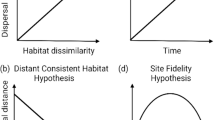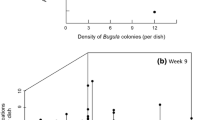Abstract
Very few details exists concerning the dispersal traits of Antarctic species and dispersal distances in particular are mostly unknown. Especially the general low number of mesoplanktonic larvae has caught attention, leading to the formulation of Thorson’s rule. From this concept, originally concerning only trophic aspects, sometimes a reduced dispersal distance is deduced. Using a generic simulation model we show that in a benthic habitat exposed to iceberg scouring, even short dispersal phases of few hours are sufficient for a pioneer species to persist. This is very surprising for a pioneer species which should be able to disperse widely and colonise distant disturbed areas which are free of superior competitors. Our model revealed that the reason for this is the non-linear dependence of the dispersal distance on the disturbance regime and on species longevity. Thus, it is the combined effect of life history and disturbance traits which is important here: a sufficiently high disturbance frequency due to iceberg scouring and a long individual lifetime due to the low temperature decrease minimum dispersal distances required for persistence and thus coexistence and present an additional explanation for the relative rarity of planktonic larvae.




Similar content being viewed by others
References
Absher TM, Boehs G, Feijo AR, da Cruz AC (2003) Pelagic larvae of benthic gastropods from shallow Antarctic waters of Admiralty Bay, King George Island. Polar Biol 26:359–364
Arntz WE, Brey T, Gallardo VA (1994) Anarctic zoobenthos. Oceanogr Mar Biol Annu Rev 32:241–304
Barnes DKA (1995) Seasonal and annual growth in erect species of Antarctic bryozoans. J Exp Mar Biol Ecol 188:181–198
Bhaud M, Koubbi P, Razouls S, Tachon O, Accornero O (1999) Description of planktonic polychaete larvae from Terre Adélie and the Ross Sea (Antarctica). Polar Biol 22:329–340
Bolker BM, Pacala SW (1999) Spatial moment equations for plant competition: understanding spatial strategies and the advantages of short dispersal. Am Nat 153:575–602
Bosch I, Beauchamp KE, Steele ME, Pearse JP (1987) Development, metamorphosis, and seasonal abundance of embryos and larvae of the Antarctic sea urchin Sterechinus neumayeri. Biol Bull 173:126–135
Bowden DA (2005) Seasonality of recruitment in Antarctic sessile marine benthos. Mar Ecol Prog Ser 297:101–118
Brey T, Gutt J, Mackensen A, Starmans A (1998) Growth and productivity of the high Antarctic bryozoan Melicerita obliqua. Mar Biol 132:327–333
Brown KM, Fraser KPP, Barnes DKA, Peck LS (2004) Links between the structure of an Antarctic shallow-water community and ice-scour frequency. Oecologia 141:121–129
Clarke A, Johnston NM (2003) Antarctic marine benthic diversity. Oceanogr Mar Biol Annu Rev 41:47–114
Connell JH, Hughes TP, Wallace CC, Tanner JE, Harms KE, Kerr AM (2004) A long-term study of competition and diversity of corals. Ecol Monogr 74:179–210
Dayton PK, Robilliard GA, Devries AL (1969) Anchor ice formation in McMurdo Sound, Antarctica, and its biological effects. Science 163:273–274
Durrett R, Levin S (1998) Spatial aspects of interspecific competition. Theor Popul Biol 53:30–43
Fahrbach E, Rohardt G, Krause G (1992) The Antarctic costal current in the southern Weddell Sea. Polar Biol 12:171–182
Fisher R (2005) Swimming speed of larval coral reef fishes: impacts on self-recruitment and dispersal. Mar Ecol Prog Ser 285:223–232
Gallardo CS, Penchaszadeh PE (2001) Hatching mode and latitude in marine gastropods: revisiting Thorson’s paradigm in the southern hemisphere. Mar Biol 138:547–552
Gatti S (2002) Die Rolle der Schwämme im hochantarktischen Kohlenstoff- und Silikatkreislauf - ein Modellierungsansatz. Report No. 434, Alfred-Wegener-Institute for Polar and Marine Research, Bremerhaven
Grantham BA, Eckert GL, Shanks AL (2003) Dispersal potential of marine invertebrates in diverse habitats. Ecol Appl 13:S108–S116
Gutt J (2000) Some “driving forces” structuring communities of the sublittoral Antarctic macrobenthos. Antarct Sci 12:297–313
Gutt J (2001) On the direct impact of ice on marine benthic communities, a review. Polar Biol 24:553–564
Gutt J, Piepenburg D (2003) Scale-dependent impact on diversity on Antarctic benthos caused by grounding icebergs. Mar Ecol Prog Ser 253:77–83
Gutt J, Sirenko BI, Smirnov IS, Arntz WE (2004) How many macrobenthic species might inhabit the Antarctic shelf? Antarct Sci 16:11–16
Gutt J, Starmans A, Dieckmann G (1996) Impact of iceberg souring on polar benthic habitats. Mar Ecol Prog Ser 137:311–316
Gutt J, Starmans A (2001) Quantification of iceberg impact and benthic recolonisation patterns in the Weddel Sea (Antarctica). Polar Biol 24:615–619
Higgins SI, Nathan R, Cain ML (2003) Are long-distance dispersal events in plants usually caused by nonstandard means of dispersal? Ecology 84:1945–1956
Hohmann (2002) Qualitative und quantitative Untersuchung von Eisbergpflugspuren im Bereich Austaasenbank (Antarktischer Schelf). Diplomarbeit, Hochschule für angewandte Wissenschaften Hamburg
Jackson JB (1986) Modes of dispersal of clonal benthic invertebrates: consequences for species distributions and genetic structure of local populations. Bull Mar Sci 39:588–606
Johst K, Brandl R, Eber S (2002) Metapopulation persistence in dynamic landscapes: the role of dispersal distance. Oikos 98:263–270
Jones GP, Planes S, Thorrold SR (2005) Coral reef fish larvae settle close to home. Curr Biol 15:1314–1318
Kowalke J, Tatian M, Sahade R, Arntz W (2001) Production and respiration of Antarctic ascidians. Polar Biol 24:663–669
Kühne S (1997) Solitäre Ascidien in der Potter Cove (King George Island, Antarktis). Ihre ökologische Bedeutung und Populationsdynamik. Report No. 252, Alfred Wegener Institute for Polar and Marine Research, Bremerhaven
Largier JL (2003) Considerations in estimating larval dispersal distances from oceanographic data. Ecol Appl 13:s71–s89
Mileikovsky SA (1971) Types of larval development in marine bottom invertebrates, their distribution and ecological significance: a re-evaluation. Mar Biol 10:193–213
Muko S, Iwasa Y (2000) Species coexistence by permanent spatial heterogeneity in a lottery model. Theor Popul Biol 57:273–284
Muko S, Sakai K, Iwasa Y (2001) Dynamics of marine sessile organisms with space-limited growth and recruitment: application to corals. J Theor Biol 210:67–80
Ragua-Gil JM, Gutt J, Clarke A, Arntz WE (2004) Antarctic shallow-water mega-epibenthos: shaped by circumpolar dispersion or local conditions? Mar Biol 144:829–839
Roughgarden J, Gaines S, Possingham H (1988) Recruitment dynamics in complex life cycles. Science 241:1460–1466
Sahade R, Tatian M, Fernanda M, Esnal GB (1998) Seasonality in reproduction of Antarctic ascidians (Molgula pedunculata, Cnemidocarpa verrucosa and Pyura setosa). Report No. 299, Alfred Wegener Institute for Polar and Marine Research, Bremerhaven
Sewell MA (2005) Examination of the meroplankton community in the south-western Ross Sea, Antarctica, using a collapsible plankton net. Polar Biol 28:119–131
Shanks A, Grantham B, Carr M (2003) Propagule dispersal distance and the size and spacing of marine reserves. Ecol Appl 13:S159–S169
Shreeve R, Peck L (1995) Distribution of pelagic larvae of benthic marine invertebrates in the Bellingshausen Sea. Polar Biol 15:369–374
Snyder RE, Chesson P (2003) Local dispersal can facilitate coexistence in the presence of permanent spatial heterogeneity. Ecol Lett 6:301–309
Stanwell-Smith DP, Peck LS, Clarke A, Murray AWA, Todd CD. (1999) The distribution, abundance and seasonality of pelagic marine invertebrate larvae in the marine Antarctic. Phil Trans R Soc Lond B 354:471–484
Svane I, Young CM (1989) The ecology and behaviour of ascidian larvae. Oceanogr Mar Biol Annu Rev 27:45–90
Teixido N, Garrabou J, Gutt J, Arntz WE (2004) Recovery in Antarctic benthos after iceberg disturbance: trends in benthic composition, abundance and growth forms. Mar Ecol Prog Ser 278:1–16
Teixido N, Gili J-M, Uriz MJ, Gutt J, Arntz W (2005) Observations of sexual reproductive strategies in Antarctic hexactinellid sponges from ROV video records. Deep-Sea Res (in press)
Thatje S, Hillenbrand C-D, Larter R (2005) On the origin of Antarctic marine benthic community structure. Trends Ecol Evol 20:534–540
Tilman D (1994) Competition and biodiversity in spatially structured habitats. Ecology 75:2–16
Todd CD (1998) Larval supply and recruitment of benthic invertebrates: do larvae always disperse as much as we believe? Hydrobiologia 375/376:1–21
Acknowledgements
We thank S.Thatje for the discussions and comments that helped to improve the manuscript.
Author information
Authors and Affiliations
Corresponding author
Rights and permissions
About this article
Cite this article
Potthoff, M., Johst, K. & Gutt, J. How to survive as a pioneer species in the Antarctic benthos: minimum dispersal distance as a function of lifetime and disturbance. Polar Biol 29, 543–551 (2006). https://doi.org/10.1007/s00300-005-0086-1
Received:
Revised:
Accepted:
Published:
Issue Date:
DOI: https://doi.org/10.1007/s00300-005-0086-1




